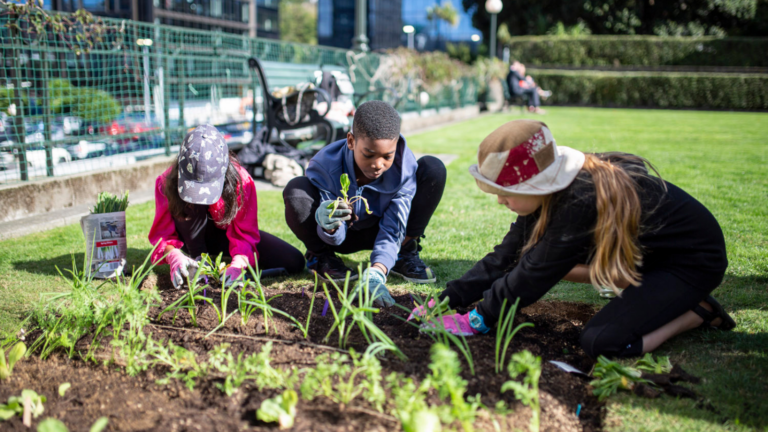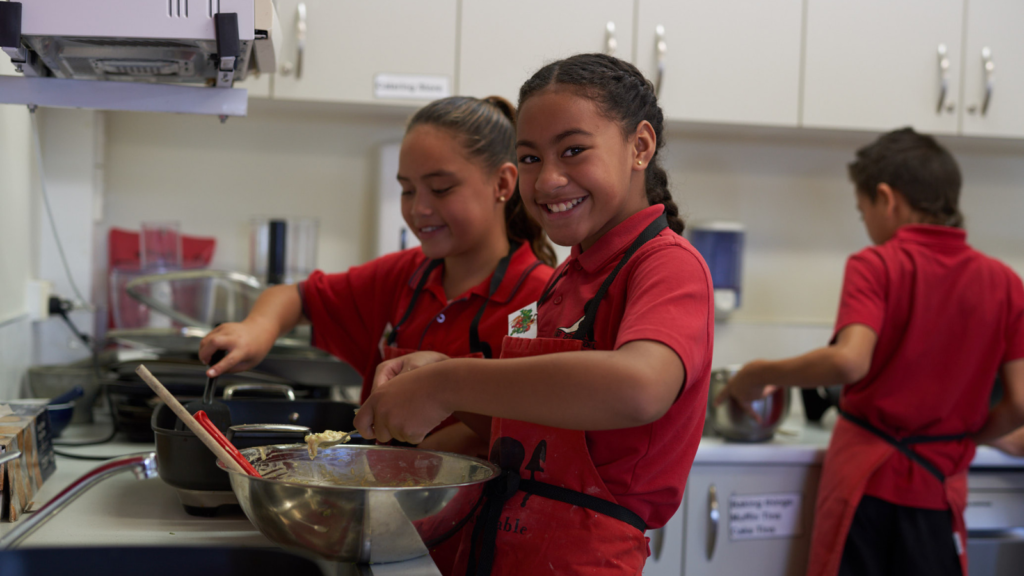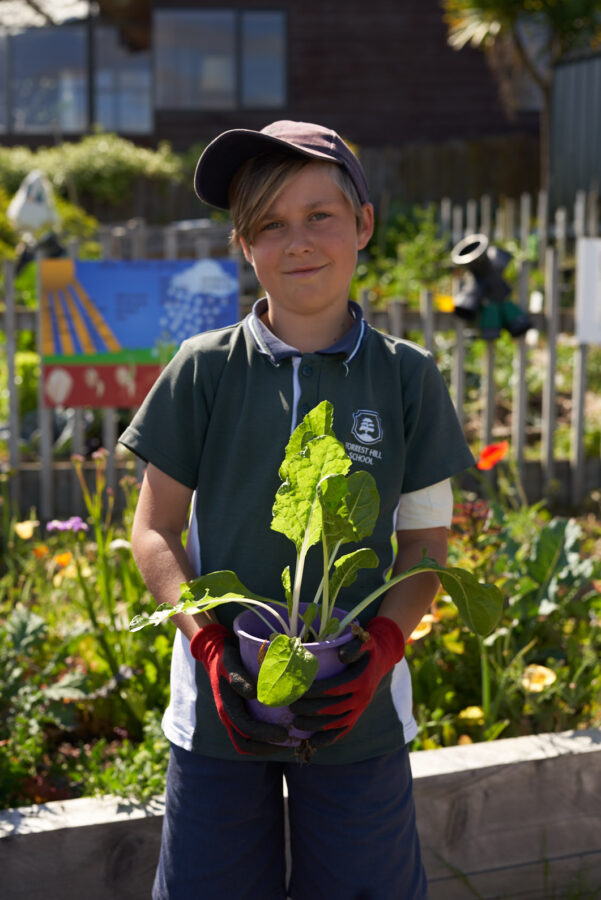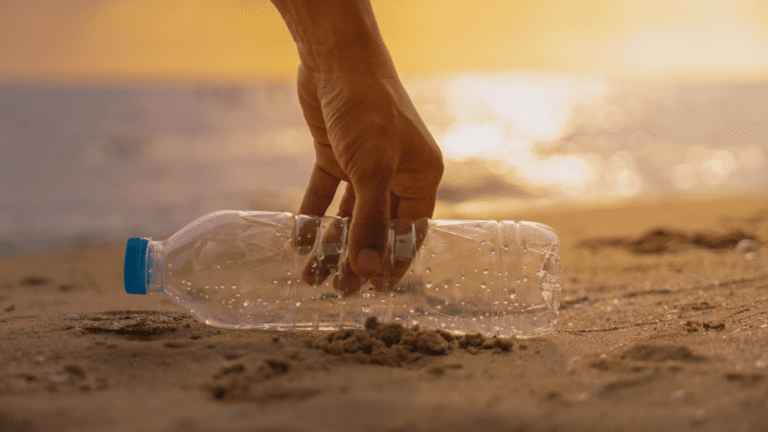The hands, hearts, and souls growing a better tomorrow

In a time dominated by headlines of the escalating cost of living, soaring prices of fruit and vegetables, and the adverse impact of screen time on our children’s development, it is hard to imagine a more compelling solution than a program that immerses children in nature, empowering them to cultivate and cook their own produce.
This is exactly what Garden to Table, a registered charity in Aotearoa, NZ, delivers. The organisation works in schools across the country to deliver a curriculum-led, hands-on program where children get practical experience growing and cooking their own food. Garden to Table’s kaupapa (purpose) is simple: to empower Aotearoa’s tamariki (children) to grow, harvest, prepare and share great kai (food).
Ani Brunet, Garden to Table’s CEO, was kind enough to share some insights into how the program came to be, and the impact it is delivering for Aotearoa’s tamariki.
Would you share with us the background to Garden to Table, and how the organisation came to be?
We were established as a charitable organisation in 2008. Catherine Bell, our co-founder and Chair, was in Australia and met up with her friend Stephanie Alexander, of the Kitchen Garden Foundation. Catherine visited a school and witnessed the program in action: school students growing, cooking, and sharing food.
She saw the power of this: the engagement of the children and how valuable the program would be in NZ. She asked Stephanie if she could bring the program to NZ and, in 2009, it was piloted in three schools.
From there, Garden To Table grew steadily and adapted to become a very Aotearoa, NZ, centric model, with 300 schools now on board from all across the country. This equates to over 30,000 students collectively growing, preparing, and eating over a million meals a year with their school whānau (family).

And how does the Garden To Table program work?
The program is a 90-minute format that is timetabled into the school’s weekly plan. In each 90-minute session, the class (generally around 30 students) is split in two.
Half head to their school garden and, led by the garden specialist and supported by adult volunteers, they garden: compost, plant, tend to seeds. They take the harvest into the kitchen where the other half of the class, led by the kitchen specialist and again supported by adult volunteers, prepare a delicious meal for them to come together and share.
My favourite part is when everyone involved, and often guests, sit down together around tables— beautifully dressed by tamariki with flowers from their school garden—and enjoy eating and kōrerorero (conversation) time together. Then it’s time to all clean up!
We are a ‘train a trainer’ model, so our small team supports schools to run the program themselves in a way that reflects their learning goals and values, and celebrates their cultures. We provide practical training, how-to guides, and help schools connect with each other as a community.
Our curriculum resources help teachers take the practical learning in the garden and kitchen and connect it to classroom learning—from maths and science to literacy and arts. The fantastic work of the school teams and volunteers is critical to the success of the program.
How do you see the role of Garden to Table in food security for young people?
We think that Garden to Table is part of the solution for issues like food security because of the role education plays in increasing access to food.
Empowering tamariki to grow and cook their own food, and connect with nature as the source of our food, shifts the dial on the future of our food systems. We are disrupting the loss of gardening and cooking skills, so children and future generations have greater connections to where food comes from. This is part of how complex issues like access to food and food security are addressed.
Hands-on food education puts skills and tools into children’s hands. Garden to Table is something that that they do regularly, not as a one-off activity, and children take it home. We’re showing children that they can grow their own food, and share in this with adults, and their whānau (family), and as a school community.
Children see that it’s not always easy to grow your own food, and that you fail sometimes, and you learn from nature and follow seasons. And they experience success and pride when they have the satisfaction of harvest. Children try more vegetables; they like eating them because they grew them, and they begin to see that growing food can be an affordable option.
We teach children how to minimise food waste, and what to do with excess produce—sharing, storing (freezing, bottling)—so that they’re naturally learning about sharing and seasonality. They compost and learn how great compost feeds soil and helps keep it healthy for them to grow their next crop of kai.
The impact extends beyond the classroom. Community groups, such as community gardens, are connecting with schools, and doing things like using spare space in front of schools to create a māra kai (food garden) where the produce is then shared with families in their community.

How do you acknowledge Te Ao Māori (the Māori world view) in the program?
Garden to Table lives in schools in Aotearoa, and there is so much to learn about growing and cooking kai from Māori as tangata whenua of this place. We are humble learners and committed to continue learning, and we support our schools to do the same.
As an example, some of our schools use the Maramataka (Māori lunar calendar) for their planning, and many of our schools are interested to learn more about this. As we learn, we share, and we bring schools together to do the same, and this encourages them to try new things.
Our educational partner is Te Reo Club. We launched this partnership at Matariki (Māori new year) last year and co-designed a set of resources, including a curriculum resource, posters and bi-lingual recipes called He Kūmara Reka (Sweet Kūmara). Michele Coxhead at Te Reo Club was incredible at weaving purākau (Māori stories and history) about how kūmara came to Aotearoa, as well as whakataukī (Māori proverbs), into the package, and it has been a real hit with our schools.
Because our program is about growing and cooking food, children are learning from Papatūānuku (mother earth) about what’s essential for growing food and how there is a reciprocal relationship. They learn for themselves how to give back, how to appreciate and nurture Papatūānuku who is providing us kai. This all centres around living in tune with Te Taiao (nature).
And finally, what is the vision for Garden to Table and how can people support this?
Our dream is that every single child in NZ has the skills and resources to grow and cook their own kai as part of everyday life. The next step towards this is our goal to be in 500 schools by 2027.
We want schools to know who we are, and how easy it is to come on board with the program.
We couldn’t do it without volunteers; we want people to know there are incredibly rewarding and fun opportunities to volunteer in schools and support kids to learn essential life skills.
We want businesses to know there are opportunities to support schools locally, or to help us nationally to support and empower children.
We also love our collaborations with other organisations in the food, health and sustainability space in schools. Visit www.gardentotable.org.nz

💚 Top 3 for sustainability
Who is the person you most admire in the sustainability space?
The children; when I visit a school, I see how the children care for and love their plants in the garden. They show me around so proudly and see themselves as kaitiaki (guardians) of the gardens. I’m always super impressed with their cooking skills, especially their knife skills when preparing vegetables.
When you eat with them, they serve the adults and each other first; the manaakitanga (kindness and respect) they show is very special. They work together beautifully, not competing. This provides me with massive motivation for my mahi (work) and hope for our food and sustainability future. The values these children demonstrate are paradigm shifting.
Is there a tool that helps you live more sustainably?
It’s not a thing, it’s a person. My daughter is an absolute eco-warrior and wāhine toa who inspires me. We both really love and enjoy living sustainably and we keep each other in check!
What advice would you share to someone looking to move into a for-purpose organisation?
Don’t give up. I feel like, I am in my 50s, and I am finally doing the job I was meant to be doing as a teenager. Back then I felt I was swimming against the tide and seen as a dreamer or radical. But none of this seems radical now, it just seems essential. I’ve come into my dream job in my 50s—so never give up!
Glimmer is committed to supporting initiatives like Garden to Table, working to help children, our communities and our planet thrive. We seek to tell the stories of the quiet sustainability heroes, working tirelessly to build a better world.
Join Glimmer, the safe and secure online community, committed to promoting wellbeing and a sustainable world, encouraging each other in a positive and inclusive space.
Looking for more stories on sustainability? See these Glimmer articles.
Sources:
Cost of living remains high for all household groups. https://www.stats.govt.nz/news/cost-of-living-remains-high-for-all-household-groups/
Kids spending one-third of after-school time on screens, study finds. https://www.otago.ac.nz/public-health-research/news/kids-spending-one-third-of-after-school-time-on-screens-study-finds#:~:text=Screen%20use%20harms%20children’s%20health,regulate%20their%20behaviour%20and%20emotions.%E2%80%9D
Story: Matariki—Te Tau Hou Māori. https://teara.govt.nz/en/matariki-Māori-new-year
Story: Papatūānuku – the land. https://teara.govt.nz/en/papatuanuku-the-land
Te Tiriti o Waitangi—the Treaty of Waitangi. https://teara.govt.nz/en/te-tiriti-o-waitangi-the-treaty-of-waitangi/print
The Kitchen Garden Community. https://www.kitchengardenfoundation.org.au/
- About the Author
- Latest Posts
Gemma is a mother of two young girls and calls Aotearoa, New Zealand home. She works in marketing and sustainability, has a Master of Business in International Business, and recently completed (and highly recommends) the University of Cambridge Business Sustainability Management course. Gemma is a passionate advocate for brands, organisations and individuals prioritising sustainability to ensure our planet can thrive for future generations.









